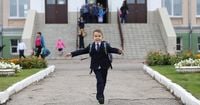In a groundbreaking study, researchers from the University of Nijmegen in the Netherlands have revealed that the academic performance of adolescent boys is significantly influenced by their friends. The findings, published in the scientific journal Research in Social Stratification and Mobility, indicate that boys often mirror the academic success or struggles of their male peers.
Analyzing data from over 10,000 schoolchildren aged 14 to 16 across the Netherlands, Germany, England, and Sweden, the researchers noted a striking correlation in the academic performance of boys within friend groups. This phenomenon highlights how social dynamics can impact educational outcomes, particularly for boys, who, in striving to meet peer expectations, may neglect their studies.
According to the study, boys initially demonstrate weaker results in language subjects while excelling in mathematics. However, by the age of 15, this initial advantage in math can diminish due to behavioral influences from their social circles. The researchers pointed out that the tendency for boys to disengage from their studies is often linked to the disciplinary behaviors of their male friends, which can lead to a culture of academic underachievement.
In a separate study, scientists from Tilburg University and Radboud University, also in the Netherlands, explored the effects of different learning formats on student performance. Their research concluded that the method of education—whether in-person or online—does not significantly affect learning outcomes. Instead, the researchers emphasized that students' ability to choose and actively participate in their learning process is paramount.
The findings, published on April 20, 2025, come at a time when many educational institutions are reassessing their teaching methods in the wake of the COVID-19 pandemic. The researchers examined a specific course, "Organization and Environment," within the bachelor's program in business administration at Radboud University. Students were given the option to attend lectures in person, watch them live, or view recorded sessions.
During the exams, students were presented with three questions related to the lecture material, and they indicated how they had engaged with the content—whether through live attendance, in-person participation, or by watching a recorded session later. This allowed for a unique comparison of the effectiveness of each learning method.
Koen van den Over from Tilburg University and his colleague Stefani Cornnef conducted the study, which revealed that regardless of the format, students achieved comparable results. "This gave us a unique opportunity to investigate whether the method of attendance influenced their understanding of the material," van den Over explained.
Interestingly, the researchers found that students who sometimes attended lectures in person and other times participated via live stream could directly compare which method worked best for their individual learning styles. This flexibility appears to enhance the educational experience, allowing students to tailor their learning to their preferences.
In light of these findings, educators may need to reconsider traditional classroom settings and explore hybrid models that incorporate both in-person and online learning options. The ability for students to engage actively in their education, regardless of the format, is crucial for fostering academic success.
As schools and universities continue to adapt to the post-pandemic landscape, understanding the social influences on boys' academic performance and the effectiveness of various learning methods will be essential in shaping future educational policies. The studies from Nijmegen and Tilburg universities provide valuable insights into these dynamics, highlighting the importance of fostering supportive peer environments and flexible learning opportunities.
With these revelations, educators, parents, and policymakers alike are encouraged to reflect on how they can better support students, particularly boys, in their educational journeys. By acknowledging the impact of peer relationships and offering diverse learning formats, we can create a more inclusive and effective educational landscape that caters to the needs of all students.




